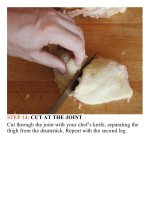The food lab better home cooking through science ( PDFDrive ) 457
Bạn đang xem bản rút gọn của tài liệu. Xem và tải ngay bản đầy đủ của tài liệu tại đây (264.42 KB, 2 trang )
It’snottheendoftheworld—what’sleftoftheskinisstill
relatively crisp, and the flesh underneathmay be perfectly
cooked,butit’scertainlynotthekindofthingthat’sgonna
impressthemother-in-law.
Aftercookingmywaythroughseveralpoundsofsalmon
filletsatvarioustemperatureranges,Ifoundthatthekeyto
getting the skin to stay intact is serendipitously the same
method that gets you the most evenly cooked, moistest,
tenderestsalmon.Andguesswhat?Thistechniquewillwork
fo rany firm-fleshed thick fish fillet, such as halibut, bass,
grouper, or snapper. I’ve broken it down into a few easy
steps.
PerfectFishTip1:PreheattheOil
Know why that fish likes to stick to the metal pan? It’s not
just a matter of being, well, sticky, it’s actually a chemical
bondthatoccursbetweenthefishandthepanatamolecular
level. This happens with all meat. With land-dwelling
animals like beef or pork, though, it’s not quite as big a
deal.The robust flesh of land animals sticks to itself better
than it sticks to a pan.The worst you’ll get is a deposit of
brownedproteinsthathavebeenexpelledfromthemeatas
itcooks.
Withtenderfish,ontheotherhand,it’sveryeasyforitto
stick to the pan better than it sticks to itself. Rather than
liftingcleanly,ittears.Thekeytopreventingthisistomake
surethattheskinheatsupasfastaspossible.Withenough
hot fat in the pan, the skin will have heated up, causing its
proteinstotightenandcoagulate,beforeitcomesintodirect
contact with the hot metal.This prevents it from forming a
strongmolecularbondwiththemetalandmakessubsequent









